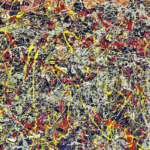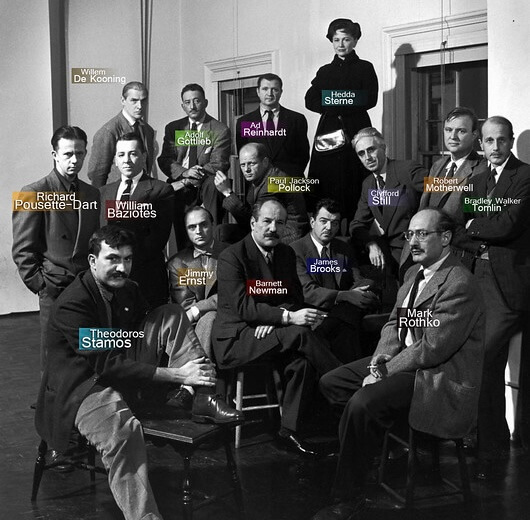Style & Definition
Abstract Expressionism emerged as a dominant force in the art world during the mid-20th century. This movement, originating in the United States, marked a significant departure from the traditional approaches of European art. Its emphasis on spontaneous, automatic, or subconscious creation distinguished it from previous art movements, embodying a new level of abstraction and emotional intensity.

Defining Abstract Expressionism
Abstract Expressionism is a term that encapsulates the work of artists who aimed to express their subconscious thoughts and emotions through non-representational art. This movement is often divided into two main categories: Action Painting and Color Field Painting. Despite their differences, both styles share common philosophical foundations and a commitment to the expressive potential of abstract art.
Characteristics of Abstract Expressionism
- Emphasis on Spontaneity and Process: Artists in this movement prioritized the process of creation over the final product. The act of painting itself became a form of expression, where the physical gesture and movement were integral parts of the artwork.
- Large-Scale Works: Abstract Expressionist paintings are often monumental in size. This scale allows for a more immersive experience, drawing viewers into the emotional and psychological space of the artwork.
- Non-Representational Forms: Unlike earlier movements that depicted recognizable subjects, Abstract Expressionism embraces abstraction. The artworks do not represent objects or scenes from the natural world but instead evoke emotions, ideas, and states of mind.
- Emotional Intensity: The artworks are characterized by their emotional intensity and dramatic use of color, line, and form. The artists sought to convey their inner experiences and the tumultuous social and political climate of their time.
- Freedom and Individualism: Abstract Expressionism celebrates individual expression and artistic freedom. Each artist’s unique style and approach are emphasized, rejecting any singular aesthetic or technique.
Action Painting
Action Painting is a style within Abstract Expressionism that focuses on the physical act of painting. This approach emphasizes the artist’s movements and gestures, often resulting in dynamic and energetic compositions.
Key Figures in Action Painting
- Jackson Pollock: Perhaps the most famous Action Painter, Pollock developed his signature “drip” technique, where he poured or splattered paint onto a canvas laid on the ground. This method allowed him to engage directly with his work, creating complex and layered compositions that captured the essence of movement and spontaneity.
- Willem de Kooning: De Kooning’s work is characterized by its vigorous brushstrokes and abstract forms that often suggest figures and landscapes. His paintings exude a sense of urgency and emotional intensity, reflecting his belief in the importance of the artist’s hand in the creative process.
- Franz Kline: Known for his bold black and white compositions, Kline’s work emphasizes the power of gesture and the dynamic interplay of positive and negative space. His paintings convey a sense of raw energy and immediacy, achieved through rapid and forceful brushstrokes.
Characteristics of Action Painting
- Gestural Techniques: Action Painters employ gestural techniques, where the artist’s movements are directly translated onto the canvas. This includes dripping, splattering, brushing, and even throwing paint.
- Focus on Process: The process of creating the artwork is just as important as the finished piece. The physical act of painting becomes a form of performance, capturing the artist’s emotions and energy in the moment.
- Dynamic and Energetic Compositions: The resulting artworks are dynamic and energetic, characterized by their sense of movement and spontaneity. The compositions are often chaotic and complex, reflecting the intensity of the creative act.
- Emotional and Psychological Depth: Action Paintings are imbued with emotional and psychological depth, as the artist’s inner experiences and subconscious thoughts are expressed through the act of painting.
Color Field Painting
In contrast to the frenetic energy of Action Painting, Color Field Painting emphasizes large areas of color and subtle tonal variations. This style focuses on creating a meditative and contemplative experience through the use of color and form.
Key Figures in Color Field Painting
- Mark Rothko: Rothko’s work is characterized by its large, luminous rectangles of color that seem to float on the canvas. His paintings invite viewers to immerse themselves in the subtle interplay of colors and experience a sense of transcendence and introspection.
- Barnett Newman: Newman’s work features vast expanses of color interrupted by vertical lines or “zips.” These zips create a sense of scale and proportion, inviting viewers to contemplate the relationship between form and space.
- Clyfford Still: Still’s paintings are marked by their jagged, irregular shapes and intense color contrasts. His work conveys a sense of primal energy and raw emotion, achieved through the bold use of color and texture.
Characteristics of Color Field Painting
- Large Areas of Color: Color Field Painters use large, unbroken areas of color to create their compositions. These fields of color are meant to evoke an emotional response and encourage a meditative experience.
- Subtle Tonal Variations: The use of subtle tonal variations and gradients creates a sense of depth and dimension within the color fields. This technique invites viewers to engage with the nuances of color and form.
- Focus on Color and Form: The emphasis is on color and form rather than gesture or narrative. The artworks are often simplified and abstract, with a focus on the emotional and psychological impact of color.
- Contemplative and Meditative: Color Field Paintings are designed to be contemplative and meditative, inviting viewers to engage with the work on a deeper, more introspective level. The large scale and immersive quality of the paintings create a sense of awe and transcendence.
The Philosophical and Cultural Context
Abstract Expressionism emerged in the aftermath of World War II, during a time of significant social, political, and cultural upheaval. The movement was deeply influenced by the existentialist philosophy that emphasized individual freedom, the search for meaning, and the expression of inner experiences.
Influence of Existentialism
Existentialist thinkers such as Jean-Paul Sartre and Martin Heidegger explored themes of individual freedom, alienation, and the search for authenticity. These ideas resonated with Abstract Expressionist artists, who sought to express their inner experiences and emotions through their art.
The Impact of World War II
The devastation and trauma of World War II had a profound impact on artists of this period. The horrors of the war and the existential questions it raised led many artists to reject traditional forms of representation and seek new ways to express the complexities of the human condition.
The Rise of New York as an Art Center
The post-war period saw New York City emerge as a major center of the art world, challenging the dominance of Paris. The city’s vibrant cultural scene and diverse community of artists provided a fertile ground for the development of Abstract Expressionism.
Legacy and Influence
Abstract Expressionism had a lasting impact on the art world, paving the way for subsequent movements and influencing generations of artists. Its emphasis on individual expression and the exploration of new techniques and forms continues to resonate with contemporary artists.
Influence on Subsequent Movements
- Minimalism: The focus on simplicity, form, and color in Color Field Painting laid the groundwork for the development of Minimalism. Artists such as Donald Judd and Agnes Martin were influenced by the reductive and contemplative aspects of Color Field Painting.
- Conceptual Art: The emphasis on the process and idea behind the artwork in Abstract Expressionism influenced the development of Conceptual Art. Artists such as Sol LeWitt and Joseph Kosuth explored the conceptual and philosophical dimensions of art, building on the foundations laid by Abstract Expressionism.
- Neo-Expressionism: The emotional intensity and gestural techniques of Action Painting found a resurgence in the Neo-Expressionist movement of the late 20th century. Artists like Anselm Kiefer and Julian Schnabel drew inspiration from the raw energy and emotional depth of Abstract Expressionism.
Continued Relevance in Contemporary Art
The principles and techniques of Abstract Expressionism continue to influence contemporary artists. The movement’s emphasis on individual expression, the exploration of new materials and techniques, and the rejection of traditional forms of representation remain relevant in today’s diverse and dynamic art world.
Conclusion
Abstract Expressionism, with its profound emphasis on individual expression, spontaneity, and emotional depth, represents a pivotal moment in the history of modern art. The movement’s two main branches, Action Painting and Color Field Painting, offer contrasting yet complementary approaches to abstraction, each with its own unique characteristics and philosophical foundations.
Action Painting captures the dynamic energy and gestural intensity of the creative process, while Color Field Painting invites viewers into a contemplative space defined by subtle tonal variations and expansive fields of color. Together, these styles reflect the broader cultural and existential concerns of their time, responding to the tumultuous social and political climate of the mid-20th century.
The legacy of Abstract Expressionism is evident in its lasting influence on subsequent art movements and its continued relevance in contemporary art. By breaking away from traditional forms of representation and embracing the expressive potential of abstraction, Abstract Expressionist artists redefined the boundaries of art and opened up new possibilities for artistic expression.
In celebrating the achievements of Abstract Expressionism, we recognize the movement’s profound impact on the evolution of modern art and its enduring significance in our understanding of creativity, expression, and the human experience.



